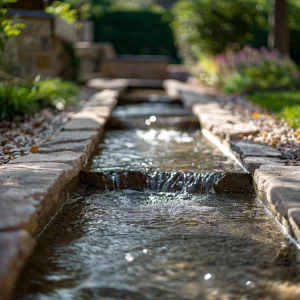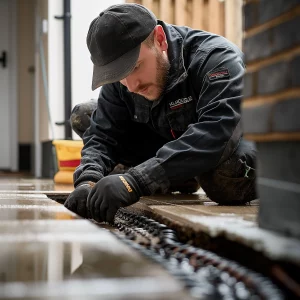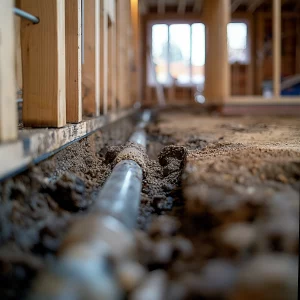Fix the Flow: Your Ultimate Guide to House Drainage Issues and Solutions
This comprehensive guide explores the essential strategies for managing house drainage issues, providing homeowners and property owners with insights into effective water flow management, soil analysis, and innovative drainage solutions. Emphasising sustainability, preventative measures, and community engagement, we outline how to protect your property from water damage, ensure regulatory compliance, and prepare for future environmental challenges.
Join us as we navigate the critical elements of developing a robust and efficient drainage system that addresses immediate concerns and contributes to your home and community’s long-term health and safety.
Managing Water Flow
The principle of directing water effectively relies heavily on understanding and leveraging gravity. This natural force can be an ally in guiding water away from structures, thereby mitigating risks associated with waterlogging and foundation damage. The key lies in creating unobstructed paths for both surface and subsurface water flow, which necessitates a strategic approach to landscape sloping and the installation of drainage systems.
The proper slope is paramount. A gradient that gently inclines away from the house ensures that water does not pool around the foundation, a common issue that leads to moisture problems, including mould and structural compromise. Achieving this requires an initial assessment and adjustment during property development and ongoing vigilance to maintain the slope’s effectiveness over time, considering factors such as soil erosion and settlement.
Soil Analysis and Management
Soil plays a pivotal role in water management, with its permeability directly influencing how water is absorbed or repelled. Different soil types, ranging from dense clay to loose sand, present unique challenges and opportunities in drainage management. A thorough analysis of the soil’s composition can inform necessary adjustments to optimise water flow, such as amending the soil with materials that enhance its absorption capabilities or adjusting the clay/sand ratio to prevent water pooling.
Maintaining soil health extends beyond its immediate impact on water absorption. Healthy soil supports robust plant life, improving erosion control and natural water management. Plants and their root systems can be strategic allies in stabilising the soil, absorbing excess water, and breaking up dense compounds that impede water flow.
Comprehensive Drainage Solutions
Addressing house drainage effectively requires a multifaceted approach that combines traditional and innovative solutions. Implementing French drains, for instance, offers a proven method for redirecting subsurface water. These trenches, filled with gravel or rock and containing a perforated pipe, are designed to intercept water before reaching the foundation and diverting it safely.
Gutter systems are crucial in surface water management, capturing rainwater from roofs and directing it away from the property. Enhancements such as gutter guards can prevent clogging, ensuring these systems function efficiently even during heavy rainfall.
The incorporation of flora in drainage solutions embodies a harmonious blend of natural beauty and utility. Strategic planting can bolster natural absorption and erosion control, making vegetation a key component in comprehensive drainage strategies.
Regular Maintenance and Upkeep
The longevity of any drainage solution hinges on regular maintenance and technical upkeep. Early detection of potential issues through routine inspections can prevent minor problems from escalating into major complications. Clearing debris from gutters, maintaining the integrity of slopes and drainage paths, and ensuring that systems like sump pumps and backwater valves are in optimal condition are all critical tasks in the maintenance regimen.
These preventive measures, paired with corrective actions when necessary, form a robust framework for managing house drainage issues effectively. By embracing both traditional methods and innovative practices, homeowners and property owners can safeguard their properties against the challenges posed by water management, ensuring that their investments remain secure and their living environments healthy.
“A well-maintained drainage system is your property’s first defence against water damage. Regular maintenance extends the life of your drainage solutions and prevents costly repairs down the line. From clearing debris to ensuring gutters and downspouts are functioning properly, these simple steps can significantly reduce the risk of foundation issues, waterlogging, and erosion. It’s not just about preventing problems; it’s about preserving the value and safety of your home,” – Mark Cordner, 24/7 Drainage UK.
Future-Proofing Drainage Solutions
In an era where environmental concerns and sustainability are paramount, integrating innovative and sustainable practices into drainage solutions addresses immediate water management needs. It contributes to the broader goals of ecological stewardship and resilience against climate change. The adoption of smart drainage systems, the utilisation of sustainable materials, and the incorporation of rainwater harvesting methods stand at the forefront of future-proofing properties against the increasingly volatile impacts of weather and climate shifts.
Smart Drainage Systems
The advent of smart technology in drainage solutions offers a dynamic approach to water management, allowing for real-time adjustments based on current weather conditions and forecasts. These systems, equipped with sensors and automated controls, can adjust the water flow through drains, redirecting it as needed to optimise efficiency and prevent overflow. Property owners can achieve a harmonious balance between innovation and nature by integrating these technologies with natural drainage solutions, such as bio-swales and rain gardens, ensuring effective water management while enhancing the natural landscape.
Sustainable Materials and Methods
The choice of materials and construction methods plays a crucial role in the sustainability of drainage solutions. Permeable paving materials, for example, allow rainwater to seep through surfaces, replenishing groundwater supplies while reducing runoff and the strain on municipal sewer systems. Similarly, the use of recycled and eco-friendly materials in the construction of drainage features minimises these solutions’ environmental footprint and promotes a circular economy.
Rainwater Harvesting
Rainwater harvesting systems capture and store rainwater for later use, turning what could be a drainage challenge into a valuable resource. This stored water can be used for irrigation, reducing the demand for municipal water supplies and providing an alternative water source during drought conditions. By incorporating rainwater harvesting into their drainage strategies, property owners can enhance their property’s self-sufficiency, contribute to water conservation efforts, and reduce their environmental impact.
Educational Awareness and Community Engagement
The effectiveness of any drainage solution is not solely the responsibility of individual property owners but also a matter of community awareness and cooperation. Educating homeowners about the importance of proper drainage, the potential risks of inadequate management, and the solutions available can empower communities to address water management challenges collectively.
Community workshops, local environmental initiatives, and school programs can significantly raise awareness and foster a culture of sustainability and proactive water management. Engaging with local experts, conservation groups, and municipal authorities can provide homeowners with the knowledge and resources needed to implement effective drainage solutions that benefit not only their property but also the community and the environment at large.
Adapting to an Uncertain Climate
The increasing frequency of extreme weather events, from heavy rainfall to prolonged droughts, underscores the need for drainage systems that are effective under current conditions and adaptable to changing climates. Developing contingency plans for extreme weather, incorporating flexibility into drainage designs, and staying informed about advancements in water management technologies are critical steps in ensuring long-term resilience.
Incorporating flexibility into drainage solutions allows for adjustments and expansions as environmental conditions change or as new areas of the property are developed. Redundant systems, such as additional sump pumps or emergency overflow areas, provide a safety net in extreme conditions, ensuring that properties remain protected even under the most challenging circumstances.
A Comprehensive Approach for a Sustainable Future
Effective house drainage management requires a multifaceted approach that encompasses the technical aspects of water flow and soil analysis and the broader considerations of sustainability, community engagement, and future preparedness. By integrating innovative technologies, sustainable practices, and educational efforts, homeowners can create resilient and effective drainage solutions that protect their properties and contribute to the well-being of their communities and the environment.
As climate patterns evolve, the importance of adaptable, informed, and collective action in water management will only increase, underscoring the need for a proactive and comprehensive approach to drainage issues.





